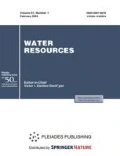Abstract
The paper highlights results obtained from collation between river water quality in mountain regions of Russia and Armenia employing two different methodological approaches: a method of a complex assessment by hydrochemical parameters by a Specific Combinatorial Water Pollution Index (SCWPI) and the Canadian Water Quality Index (CWQI). Assessment was done of water quality of typical, identical in terms of conditions of formation small- and medium-size mountain rivers in Russia (river Terek basin: the Malka, the Baksan, the Cherek) and Armenia (rivers Kura-Araks basin: the Vorotan, the Voghchi, the Pambak). Collation was done between results of a complex assessment of water quality in mountain rivers obtained employing two indices: SCWPI and CCME WQI and two sets of norms: maximum allowable concentrations (MAC) set for fishery waters and ecological norms, and critical water pollution indices (CPI) and the highest excursive indices, defined. As shown, the river water quality classes by both indices coincide when using ecological norms, whereas difference in assessment results obtained through different methods employing common MAC set for fishery waters is primarily determined by more stringent values of MAC set for heavy metals. As an ultimate result, water quality in the studied rivers is characterized as marginal (the 4th class) for the Malka, the Baksan, the Cherek and the Voghchi and fair (the 3rd class) for the Vorotan and the Pambak. Methodological approaches to river water quality and pollution levels to be developed need to focus primarily on application of ecological (regional) norms or background hydrochemical parameters accounting for natural and climatic peculiarities of river watersheds.

Similar content being viewed by others
REFERENCES
Canadian Council of Ministers of the Environment. Canadian Water Quality Guidelines for the Protection of Aquatic Life: CCME Water Quality Index 1.0, User’s Manual, in Canadian Environmental Quality Guidelines, 1999, Canadian Council of Ministers of the Environment, Winnipeg. http://ceqg-rcqe.ccme.ca/download/en/138.
EN Official Journal of the European Communities 5.12.98 Council Directive 98/83/EU on The Quality of Water Intended for Human Consumption as of 3 November, 1998. https://eur-lex.europa.eu/LexUriServ/ LexUriServ.do?uri=OJ:L:1998:330:0032:0054: EN:PDF.
Gagarina, O.V., Assessing and normalizing natural water quality: criteria, methods, current issues, A Teaching and Methods Manual, 2012, Izhevsk: Publ. h. Udurmutski Universitet.
Khublaryan, M.G. and Moiseenko, T.I., Water Quality, Newletters RAS, 2009, vol. 79, no. 5, pp. 403–410.
Methods guidelines on developing schemes of complex utilization and protection of water bodies, approved by the Ministry of Nature Resources RF, Order no. 169 as of July 4, 2007.
National Report—About the status and protection of the environment of the Russian Federation in 2017, M., Minprirodi Rossii, Publ.h. Cadastre, 2018.
RA Government Resolution no. 1749-N 04, 2004, About establishing territorial management basins and ratifying their plans (in Armenian).
RA Government Resolution (2011) of N 75–N 27, About determination of standards for ensuring the quality of water in individual water basins of the Republic of Armenia, depending on the particular terrain (in Armenian).
RD 52.24.643-2002. Methods guidelines. The methods of integral assessment and pollution level of surface waters by hydrochemical indices, SPb., Gidrometeoizdat. https://files.stroyinf.ru/Data2/1/4293831/4293831806.pdf.
Reutova, T.V., Dreeva, F.R., and Reutova, N.V., The dynamics of the content of basic micro elements in glacial rivers of the Central Caucasus, Water: Chem. Ecol., 2015, no. 4, pp. 3–9. http://watchemec.ru/en/article/27251/.
Reutova, N.V., Reutova, T.V., Dreeva, F.R., Khutuev, A.M., and Kerimov, A.A., Features of aluminum concentrations in rivers of the mountain zone of the Central Caucasus, Russian J. General Chem., 2018, vol. 88, no. 13, pp. 2884–2892. https://link.springer.com/article/10.1134/S1070363218130091https://doi.org/10.1134/S1070363218130091
Saghatelyan, K.A., Babayan, G.H., and Sahakyan, L.V., The hydrochemistry of rivers of Armenia and Nagorno-Karabakh, 2017, LAP LAMBERT Academic publ., ISBN: 978-620-2-06203-9.
SanPiN 2.1.4.1074-01 Drinking water, Hygienic requirements to the quality of water from centralized water supply systems, Order N24, 2001 of Health Minister http://www.mast.is/library/Regluger%C3%B0ir/Russland/SanPin%202_1_4_1074-01_ForWater.pdf.
SanPiN 2.1.5.980-00. Sanitation rules and norms, Hygienic requirements to surface water protection, approved by Chief State Sanitarian RF as of June 22, 2000. http://docs.cntd.ru/document/1200006938.
Surface water resources of the USSR, West Transcaucasia, vol. 9, Ed. 1, L.: Gidrometeoizdat, 1969.
Surface water resources of the USSR, River Araks Basin, vol. 9, Ed. 2, M.: Gidrometeoizdat, 1973.
The Atlas of the Kabardino-Balkar Republic, Buraev, R.A., Ed., M.: Federal Geodesy and Cartography Service of Russia, 1997.
The National Atlas of Armenia, Yerevan, 2007 (in Armenian).
Tsupikova, N.A., Theoretical fundamentals of water quality assessment in natural water bodies in the RF and EU, RUDN University Newsletter, a series Ecology and Life Safety, 2016, no. 1, pp. 65–76.
Water Code of the Russian Federation, RF Law № 74-FL as of June 3, 2006. http://www.cabri-volga.org/DOC/ PolicyRoundtable/WaterCodeOfRF-UnofficialEnglish-Translation.pdf.
Water Code of the Republic of Armenia. RA Law as of June 4, 2002. https://www.ecolex.org/details/legislation/ water-code-of-the-republic-of-armenia-lex-faoc034344/.
WHO (World Health Organisation), Guidelines for drinking water quality, 4th Ed., Geneva, 2001. https://apublica.org/wp-content/uploads/2014/03/ Guidelines-OMS-2011.pdf.
Author information
Authors and Affiliations
Corresponding authors
Rights and permissions
About this article
Cite this article
Babayan, G., Reshetnyak, O. & Zakrutkin, V. A Comparative Assessment of River Water Quality in Mountain Regions of Russia and Armenia. Water Resour 48, 102–110 (2021). https://doi.org/10.1134/S0097807821010115
Received:
Revised:
Accepted:
Published:
Issue Date:
DOI: https://doi.org/10.1134/S0097807821010115




